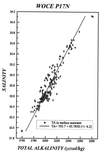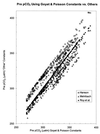Direct observation of the oceanic CO2 increase revisited
- PMID: 11607738
- PMCID: PMC33732
- DOI: 10.1073/pnas.94.16.8308
Direct observation of the oceanic CO2 increase revisited
Abstract
We show, from recent data obtained at specimen North Pacific stations, that the fossil fuel CO2 signal is strongly present in the upper 400 m, and that we may consider areal extrapolations from geochemical surveys to determine the magnitude of ocean fossil fuel CO2 uptake. The debate surrounding this topic is illustrated by contrasting reports which suggest, based upon atmospheric observations and models, that the oceanic CO2 sink is small at these latitudes; or that the oceanic CO2 sink, based upon oceanic data and models, is large. The difference between these two estimates is at least a factor of two. There are contradictions arising from estimates based on surface partial pressures of CO2 alone, where the signal sought is small compared with regional and seasonal variability; and estimates of the accumulated subsurface burden, which correlates well other oceanic tracers. Ocean surface waters today contain about 45 micromol.kg-1 excess CO2 compared with those of the preindustrial era, and the signal is rising rapidly. What limits should we place on such calculations? The answer lies in the scientific questions to be asked. Recovery of the fossil fuel CO2 contamination signal from analysis of ocean water masses is robust enough to permit reasonable budget estimates. However, because we do not have sufficient data from the preindustrial ocean, the estimation of the required Redfield oxidation ratio in the upper several hundred meters is already blurred by the very fossil fuel CO2 signal we seek to resolve.
Figures





References
-
- Ciais P, Tans P P, Trolier M, White J W C, Francey R J. Science. 1995;269:1098–1102. - PubMed
-
- Tans P P, Fung I Y, Takahashi T. Science. 1990;247:1431–1438. - PubMed
-
- Tsunogai S, Ono T, Watanabe S. J Oceanogr. 1993;49:305–315.
-
- Siegenthaler U, Sarmiento J L. Nature (London) 1993;365:119–125.
-
- Callendar G S. Q J R Meteorol Soc. 1938;64:223–240.
LinkOut - more resources
Full Text Sources

